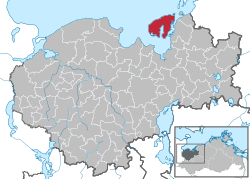Poel
| Insel Poel | ||
|---|---|---|
|
||
| Coordinates: 54°00′N 11°26′E / 54.000°N 11.433°ECoordinates: 54°00′N 11°26′E / 54.000°N 11.433°E | ||
| Country | Germany | |
| State | Mecklenburg-Vorpommern | |
| District | Nordwestmecklenburg | |
| Government | ||
| • Mayor | Gabriele Richter | |
| Area | ||
| • Total | 36.02 km2 (13.91 sq mi) | |
| Elevation | 0-26 m (−85 ft) | |
| Population (2015-12-31) | ||
| • Total | 2,497 | |
| • Density | 69/km2 (180/sq mi) | |
| Time zone | CET/CEST (UTC+1/+2) | |
| Postal codes | 23999 | |
| Dialling codes | 038425 | |
| Vehicle registration | NWM | |
| Website | www.insel-poel.de | |
Poel (German pronunciation: [ˈpøːl]) or Poel Island (German: Insel Poel), is an island in the Baltic Sea. It forms the natural northern and eastern boundaries of the Bay of Wismar on the German coast. The northern coast of the island is also on the south side of the large gulf known as the Bay of Mecklenburg, which Wismar Bay enters into. Insel Poel thus forms on its northern side the unofficial latitude of the northern boundary of the Wismar Bay.
It is close to the cities of Lübeck, Wismar and Schwerin and is part of the Hamburg Metropolitan Region.
Administratively it is a municipality in the Nordwestmecklenburg district. It consists of Kirchdorf and Oertzenhof (the main towns) and the smaller villages of Timmendorf, Wangern, Hinterwangern, Weitendorf, Weitendorf-Hof, Brandenhusen, Neuhof, Seedorf, Niendorf, Schwarzer Busch, Kaltenhof, Fährdorf, Malchow, Vorwerk and Gollwitz. It covers an area of 36.02 km2 (13.91 sq mi) and has 2,873 citizens. Satellite pictures show that most of it is used as farmland. With its good air, clean water, fine beaches and sheltered harbours, it is also popular recreational area. At Timmendorf harbour there are a pilot's station and facilities for yachts and local fishermen. Kirchdorf has a yachting harbour and a boatyard. Wismar Bay is cited by the 1911 Encyclopædia Britannica as the finest harbor on the Baltic.
The island's name derives from pole, the Common Slavic word for "flat land" or "field".
Poel's first inhabitants in historic times were Slavs, belonging to the West Mecklenburgian tribe of the Obotrites. The Slavic ruler and Lord of Mecklenburg Heinrich Borwin I brought German settlers from the providences of Dithmarschen and Holstein to the island in the early 13th century. They began building the church on Poel around 1210. The church was built in four or five periods and was completed around 1350. The tower (the oldest part of the building) is in Romanesque style, and with its 47 meters it is visible from almost all points on the island. The church nave was originally Romanesque in style, was enlargened however around 1300 with a long and high choir and at that time changed into the Gothic style. The church which still remains a major sightseeing attraction on the island contains two winged Marian altars from the 15th century, a triumphal cross from around 1450, a rare Danish gravestone from the 13th century and the model of a Zeesenboat from 1936. Since about 1535 it is a Lutheran Church. Besides the weekly Divine Service there are also many concerts with classical music in the church during the summer months.
...
Wikipedia



